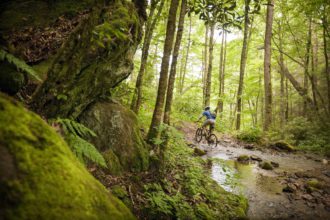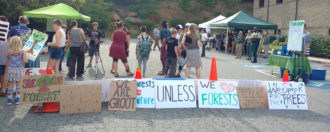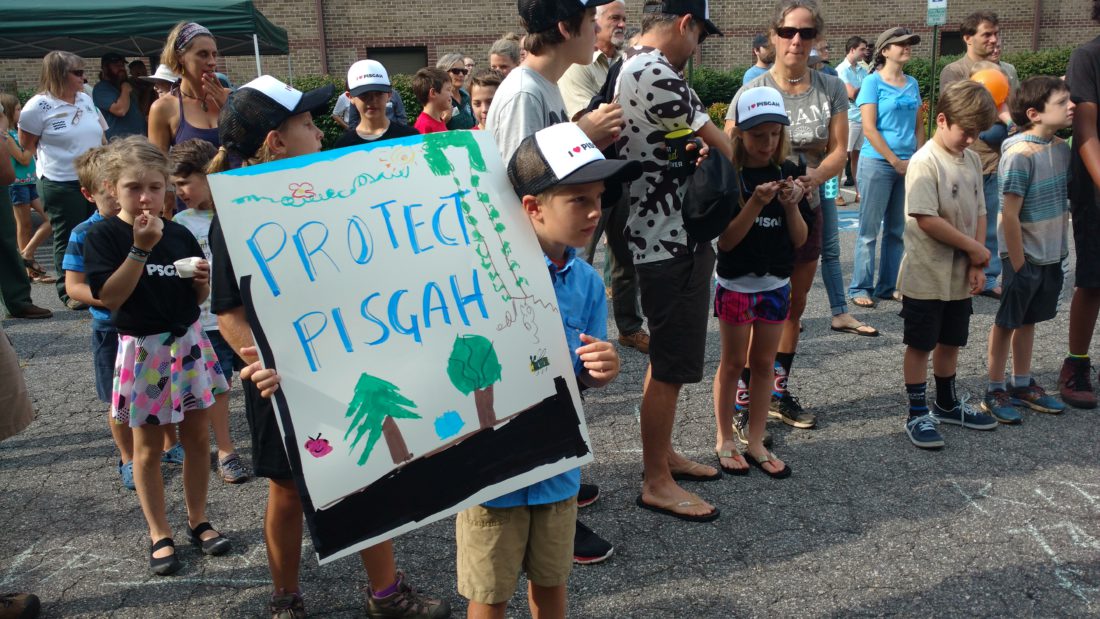The tan- and green-uniformed members of the U.S. Forest Service looked somewhat out of place at their own Asheville headquarters on the morning of Aug. 17. A festival had sprung up right outside the building on the north edge of Montford, with over 100 children and their parents on hand to celebrate the Pisgah and Nantahala national forests (and eat free ice cream from The Hop).
This party had a purpose, explained I Heart Pisgah organizer Will Harlan from a stage in the parking lot. Sometime early next year, Forest Service staff are expected to release a complete draft of the new Nantahala and Pisgah National Forests Plan. The final plan, slated for approval in late 2019, will guide the management of 1.1 million acres in Western North Carolina for many years to come.
“The youth need to have a voice in this plan,” Harlan said. “Because this plan will last for decades, and they’re going to be the ones inheriting the decisions that are made next fall.”
Many attendees held colorful signs with slogans declaring their allegiance to strong forest protections. Particularly popular were images and lines from The Lorax, Dr. Seuss’ environmentalist children’s classic. Slogans such as “We speak for the trees” and “Trees are what everyone needs” urged the Forest Service to make conservation a top priority.
“What are the most important values that this forest has? Often, I find that children can articulate those values better than we can,” said Harlan. “While they may not be able to recite the exact number of acreage that’s in old growth, they know that big trees matter.”
But the kids represent just one of the many voices debating how best to manage the national forests. Since early 2014, the Forest Service has conducted over 40 input events throughout the region, received nearly 15,000 public comments and organized a Stakeholders Forum of close to 30 members that meets regularly.
While this long-running process has made considerable progress toward consensus on a vision for the forest, sticking points still remain. Conservationists continue to disagree with some hunting advocates and logging industry groups about protected area designations and the extent of active land management.
Rooted in community
For Michelle Aldridge, planning and National Environmental Policy Act officer with the Forest Service, the past several years have been an experiment with an “unprecedented degree of public involvement.” The Nantahala and Pisgah plan is one of the first to be revised under new federal regulations, introduced in 2012, that emphasize community engagement.

In the current draft plan, Aldridge says, public involvement is considered alongside water, air and soil as a valuable natural resource for the Forest Service to manage. Locals who frequently visit far-flung areas of forest, for example, might share information about the species that live there and help officials determine if the agency’s forestry practices are achieving the desired goals.
The draft also considers the public’s potential engagement with the forest once the initial planning is complete. Aldridge points to a system of “tiered objectives” for main Forest Service goals such as invasive plant management. The lowest levels are realistic for the agency working by itself, while higher tiers project the impact staff could have by working with community partners.
“Tier 1, based on the last 10 years of activity and what we expect our budget capacity to be into the future, is that we would control or eradicate nonnative invasive plant species on 750-1,500 acres, then inventory approximately 1,000-2,000 acres for additional species,” Aldridge explains. “Tier 2 would double the amount of acres where we’re doing that control or eradication, and we would inventory twice as much. We’d be managing along the boundary of the forest, working with adjacent private landowners or communities.”
Writing a plan with this public context in mind has taken the Forest Service longer than initially expected. The draft, initially due out in spring, will not be released until early 2019. “Every page of the plan has the fingerprints of public involvement on it, and to do that right, you have to take time,” says Aldridge. She also cites the need for extensive analysis to determine the impacts of different scenarios on wildlife and natural resources as a cause of delay.
Gary Kauffman, a Forest Service botanist and plant ecologist, favors a lengthy process over the alternative. When he worked on plan revisions for the Uwharrie National Forest in North Carolina’s Piedmont region, the public didn’t offer much feedback. That made it “easier to get things done, but that doesn’t mean it’s right,” he says.
Forest for the trees

Kauffman is quick to identify the main reason behind the protracted planning. “Probably the most contentious stuff is those areas that some people want to cut and other people don’t,” he says. “It’s the same thing that has happened probably everywhere: Some people want to preserve as wilderness, whereas others might want to do some other things.”
I Heart Pisgah’s Harlan argues that the issue shouldn’t be contentious at all. Of the nearly 15,000 public comments on the plan to date, he notes, 98 percent support stronger and further-reaching protections for the forest. “That’s a pretty clear, overwhelming public mandate saying ‘We want protected areas,’” he says.
Although the average annual forest harvest in the Nantahala and Pisgah forests combined is currently 650 acres — less than a tenth of a percent of the total area — Harlan says the latest preliminary plan proposes an increase in permits to 4,000 acres annually, with some forestry advocates calling for a yearly harvest of as much as 12,000 acres. He also notes that the Appalachian Trail corridor and other major scenic trails don’t have permanent protection from logging.
“The tourism economy is the economic engine of the mountains and is the future of Southern Appalachia,” Harlan says. “We’re going to see the most economic and ecological impact by protecting those views, not cutting them down.”
The Forest Service itself, Harlan asserts, has largely allied with timber interests and hunting groups in resisting expanded protected-area designations. “They see it as limiting the tools in their toolbox,” he says. “They want to maximize the amount of flexibility in this plan so they can manage the forest however they want, whenever they want, wherever they want.”
Patty Matteson, public affairs specialist for the Forest Service, emphasizes that the agency’s approach to timber management centers on improving forest health and preserving ecosystem services such as water quality. She also points out that the plan itself cannot establish new protected areas; instead, North Carolina-based staff would make recommendations at the federal level, which would in turn need to be approved by Congress.
Conservation groups, Harlan clarifies, aren’t totally opposed to logging. They approve of selected timber harvests for purposes such as restoring degraded areas. But with over 125,000 acres of old-growth forest not currently protected, he says, cautious management is key.
Loggerheads
The objections of some groups to protected areas, however, have been categorical. Jim Gray, who represents the Ruffed Grouse Society on the Stakeholders Forum, says he’s resisting new designations on behalf of multiple county governments, none of which are themselves included on the forum.
Of the 19 North Carolina counties with land in the Pisgah or Nantahala forests, Gray says, at least 12 have passed resolutions opposing additional protections, including Henderson, McDowell, Transylvania and Yancey. “They felt like [these designations] completely took away the option for active management and impacted their economies,” he explains.
Gray is also skeptical of widespread protections based on his experience as a hunter. The popular “Disney image” of abundant wildlife under a closed canopy of big trees, he says, doesn’t square with the ecological reality that different species fill different niches.
“There’s no food in a closed-canopy forest. When you open it up, you get the growth of shrubs and grasses when the sun reaches the forest floor, which supports deer and a lot of other animals,” Gray says. “I’m in these mountains a lot during grouse season and rarely do I see a deer — and anymore, rarely do I see a grouse.”
Other groups draw a softer line against expanded protections but agree that more active management generally supports a wider diversity of forest uses. Chris Coxen, a district biologist with the National Wild Turkey Federation, says both game animals and species that attract sightseers benefit from a mix of habitats.
“Old-growth forest is certainly beautiful and worth protecting, but not all wildlife species live in old-growth forest,” Coxen points out. “Even mature forest species use young forest habitats. It’s sort of the buffet, because it grows a lot of bugs and other things that critters eat.”
Lang Hornthal, executive director of local forestry group Root Cause, encourages people to take a longer-term view of forest management. While it’s easy to generalize that the industry is destructive, he says, forest products often require less energy to produce than metal or plastic equivalents and are crucial to North Carolina’s economic health.
“If you just stand beside and look at a tree and a chainsaw’s going through it, without knowing why it’s being cut and what it’s going to be used for, then I think it’s really hard to understand the importance the forest product industry plays in our state,” Hornthal says.
Clearing the trail
Both Coxen and Hornthal say that the differences between stakeholders are less important than the robust conversation that’s taken place over the past several years of planning. They hope that the passions raised during the process can be leveraged into ongoing advocacy for the forest at the federal level.
“I think that if we channel our energy for all the things we care about and how that forest plan could represent all of those things, collectively that’s a really powerful message,” Coxen explains. “If we’re divided on how the forest should be managed, it’s a lot harder to channel that energy.”
The conversation will continue after the Forest Service releases its final draft plan in early 2019. Aldridge notes that the draft will contain multiple alternatives for protected area recommendations, as well as environmental impact considerations for each option. Once those documents are made available, public comment will reopen for an additional 90 days.
“There’s just some anxiety because folks haven’t had an opportunity to see how we’re responding to public comment,” Aldridge says. “I believe that all of the multiple uses of the forest can be met on over 1 million acres and that we can do that in a way that meets everybody’s interests.”



Before you comment
The comments section is here to provide a platform for civil dialogue on the issues we face together as a local community. Xpress is committed to offering this platform for all voices, but when the tone of the discussion gets nasty or strays off topic, we believe many people choose not to participate. Xpress editors are determined to moderate comments to ensure a constructive interchange is maintained. All comments judged not to be in keeping with the spirit of civil discourse will be removed and repeat violators will be banned. See here for our terms of service. Thank you for being part of this effort to promote respectful discussion.